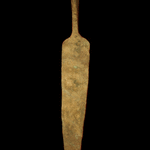Yoruba Brass Ceremonial Knife, 19th Century CE - 20th Century CE
Brass
18.75
PF.5056
The ceremonial sword and knife are important symbols of power and authority. High ranking individuals wear the usdamalore, (a small, ornate ceremonial sword), during festivals to designate them as someone...
The ceremonial sword and knife are important symbols of power and authority. High ranking individuals wear the usdamalore, (a small, ornate ceremonial sword), during festivals to designate them as someone of prestige. At Ilesha, (central Yorubaland), the chief strikes the blade of his sword on the earth three times when he greets Ogun, god of iron. Swords and knifes are emblems not only of wealth, but also of the power latent within the metal itself to cause destruction or to protect. Just as an individual possessing power, both earthly and spiritual, may use the weapon for aggressive or passive purposes depending upon his judgment and wisdom.
There are four distinct sections on the blade of this knife. The middle panel contains striated semi-circles, two of which are formed into arrows pointing in opposite directions. On the lower portion four triangles are created by thick bands in an X-shape. The top square has six diagonal bands filled with concentric circles and diagonal striations. This forms a base for the prostrate bird lying on its back, looking up at a stylized lizard who seems to be attacking the bird. The iconography on this blade seems both primordial and modern; harking back to the mysterious past, yet still connected with the rituals of the present.
There are four distinct sections on the blade of this knife. The middle panel contains striated semi-circles, two of which are formed into arrows pointing in opposite directions. On the lower portion four triangles are created by thick bands in an X-shape. The top square has six diagonal bands filled with concentric circles and diagonal striations. This forms a base for the prostrate bird lying on its back, looking up at a stylized lizard who seems to be attacking the bird. The iconography on this blade seems both primordial and modern; harking back to the mysterious past, yet still connected with the rituals of the present.



